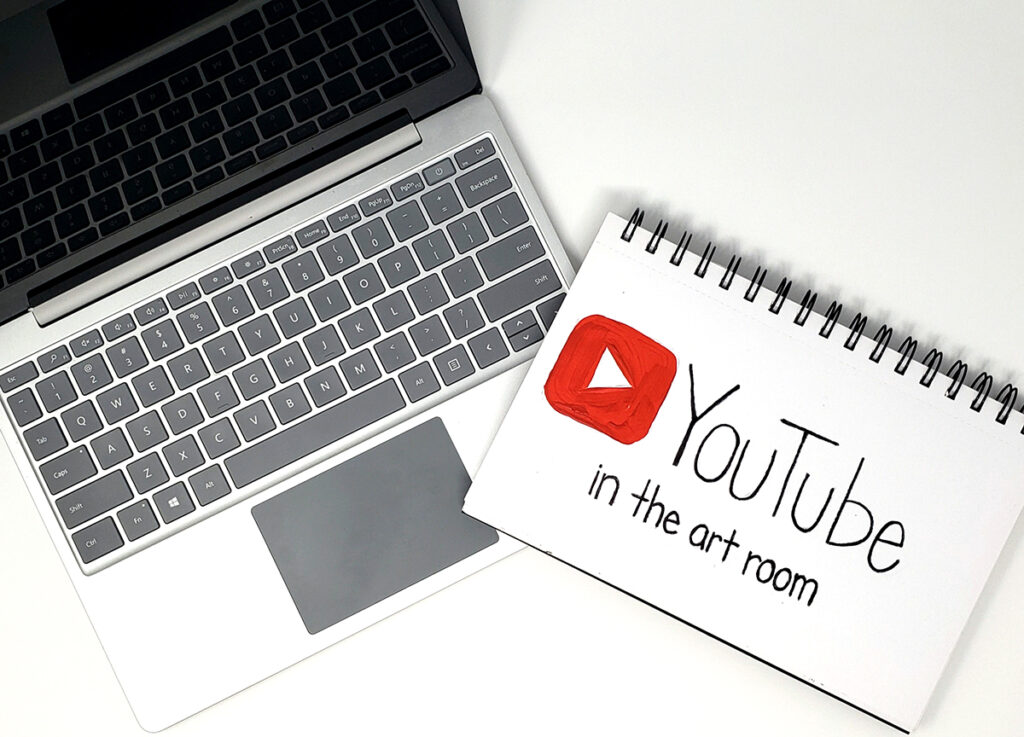Many students spend hours watching their favorite YouTuber’s videos, so why not use the platform as a learning tool? YouTube videos offer attention-grabbing graphics and animations that are often beyond what teachers have the time to create. It’s these features that capture and, more importantly, keep the students’ attention. Eugene Maziriri supports this in his 2020 article, Student Perceptions Towards the Use of YouTube as an Educational Tool for Learning and Tutorial. Maziriri’s study shows YouTube videos not only hold students’ attention but also have a positive impact on learning when used appropriately.

YouTube videos are also beneficial because they help students see successful artists who implement the same techniques they learn in class. It exposes students to artists around the world who encounter and overcome hurdles similar to the ones students face in the artmaking process.
Showing students YouTube videos is just the beginning of their potential in the classroom. Here are three other ways to use YouTube in the classroom:
- Add videos to a playlist of tutorials for students to browse during independent learning time or as they research art history movements.
- Create your own YouTube channel by uploading recorded tutorials and demonstrations you create in class. It can act as a centralized place for students to revisit the concepts or techniques you taught, as well as a way for you to share your knowledge with YouTube users around the world.
- Have students create video tutorials and post them to a class YouTube channel. Students don’t have to show their faces and can film showing only their hands as they narrate their artistic process.
If you are ready to start curating a list of videos to incorporate into your classroom, here are ten videos to inspire, motivate, and engage your high school art students.
Note: Preview all videos before showing them to your students to ensure they are appropriate.
1. Iris Scott Is A Master Finger Painter — And Her Paintings Sell For $40,000
Play is an important learning tool at any age. Students need to know they can take lighthearted and simple techniques and transform them into more complex, elevated art. Iris Scott is a great example of both of these. She takes the simple art of finger painting and creates large-scale masterpieces that sell for huge sums of money. Have your students watch this video to see more of her process and the intent behind her art. It may even encourage the students to give Scott’s finger-painting methods a try!
2. Embrace the Shake by Phil Hansen
Art classes can bring out students’ insecurities, especially those with disabilities. It’s important to emphasize that many successful artists have embraced their physical and cognitive barriers to create art. TEDx’s The Shake shows how to embrace perceived physical limitations and incorporate them into art. It’s encouraging for students with physical disabilities to see people like them, but it’s also encouraging for students who feel like they are “bad” at art. If people with barriers can embrace all parts of who they are to create great art, all students can start to think they can too!
Here are some additional resources to help create an inclusive art room:
- What Do the 7 Principles of Universal Design Look Like in the Art Room?
- 9 Tips to Integrate Artists With Disabilities and 7 Artists to Share
- Differentiation in the Art Room Pack in PRO Learning
- Understanding and Implementing IEPs Pack in PRO Learning
- Adapting the Art Room graduate course
3. CGI 3D Animated Short “Origami” by ESMA
The animated Origami is a gripping short film that highlights the rhythmic, therapeutic nature of origami while acknowledging that learning the art form can be difficult. It also alludes to origami’s roots in Japanese culture, how it is passed down through generations, and its ability to bring people together. Show it as an introduction to origami to get your students interested, or show it after an origami unit to transition into a stop-motion animation project to incorporate the students’ origami creations.
For a shorter introduction to origami, watch Step into a Miniature World of Animated Paper Wildlife. If you want to use this video to introduce digital animation instead, check out the Pack, Digital Animation in PRO Learning to learn how to teach this art form.
4. Stealing the Mona Lisa: The Art Theft of the Century
Older students usually recognize the Mona Lisa, but not many students understand why it’s famous. Is it her alluring smile, the eyes that follow the viewer, or Leonardo Da Vinci’s use of sfumato? Even these elements may not be enough to convince students it deserves the unending admiration it receives. This video investigates what really sprung the Mona Lisa to fame—an intriguing museum heist. This video can be a springboard into discussions about what determines the value of an artwork or stolen art throughout history.
For more video exploration about stolen artwork, check out these two videos:
- The strange history of the world’s most stolen painting – Noah Charney
- Stolen de Kooning painting worth $165M found behind a bedroom door
5. Meet The Last Family Keeping The 400-Year-Old Rogan Art Alive
In a world of mass-manufactured textiles, it’s hard for students to imagine many surface design techniques were once done only by skilled artisans who created elaborately designed fabrics for the rich. Batik is a wonderful introduction to traditional surface design techniques, but there are many other historical and traditional techniques to explore. This video shares one family’s quest to keep the tradition of Rogan alive in spite of the obstacles from mass manufacturing, time, and the Covid-19 pandemic. Have your students watch this video as an introduction to surface design, a unit on traditional Indian art, or even when discussing the resilience small business owners need to thrive.
6. Artist Draws Hyperrealistic Portraits Using Bic Ballpoint Pens
Even students who don’t consider themselves artistic sometimes take to doodling with their pens during lectures. This video shows how ballpoint pens can be used for more than just doodles. Artist Oscar Ukonu takes ballpoint pen drawings to the next level through hatching, cross-hatching, and scribbling to create lifelike artwork. It isn’t all about the medium, though. His politically charged artworks send a bold message in spite of the simplicity of his tool.
As students watch Ukonu draw hyper-realistic portraits, they may want to try it out too! Teaching figure drawing can be daunting, but Tim Bogatz breaks it down for you in the Pack, Drawing the Human Form in PRO Learning. Use Bogatz’s methods and Ukonu as inspiration, and you will be well on your way to a successful figure-drawing unit.
7. Who Decides What Art Means?
What does art mean? It’s something art teachers try to help their students understand through analysis, but at the end of the day, does the artist determine the meaning, or does the viewer? It’s an important discussion to have with your students so they can understand other perspectives and ultimately figure out how to convey meaning through their own work. Use this video as an introduction to art analysis and then have students decide what they think an artwork means.
8. Highest Paying Jobs For Art Majors! (Top 10 Jobs)
Students need to know you don’t have to be a starving artist if you have a career in the arts. They also need to know there are other artistic and creative jobs besides painters or graphic designers. While this video is a bit long, it’s comprehensive and gives a great description of what’s involved in each career.
If this video sparks a student’s passion for an artistic career, watch the Pack, Readying Students for College And Careers in PRO Learning, and read this article with tips to prepare them for life beyond high school.
9. Color Theory – A Beginners Guide
There is a lot of color theory packed into this video. In fact, there is so much information it could be broken up into three separate lessons. However, Brad’s Art School breaks the information down in a way that is not only easy to absorb but also entertaining. If you like this one, check out Brad’s Art School videos on his YouTube channel! He creates clean yet fun videos about many basic art concepts, which makes them great additions to your curriculum.
To brush up on your color theory knowledge, explore new ways to introduce your students to color theory, and learn more about how colors impact emotions, check out the Color Theory Basics Pack in PRO Learning.
10. Landscape Painting Time-lapse | “A Brief Moment”
Let’s face it—most of the time, students don’t like to trust the process. This is especially true in art class because they don’t want their friends or teacher to judge the messy parts before an art piece starts to come together. This is why beginning painters tend to work without underpainting, meticulously paint inch by inch, and have a hard time focusing on the canvas as a whole. Because many beginner artists choose to paint landscapes, this time-lapse is a great option to help them understand the importance of underpaintings, working many areas of the canvas at once, and how to effectively create atmospheric perspective.
Once students have a better understanding of what it takes to paint landscapes effectively, you can have them create advanced landscapes like the ones in the Two-Point Perspective Landscapes Lesson in FLEX Curriculum.
Whether you create videos, show other creators’ videos, or have your students make them, YouTube videos are worth incorporating into the classroom. YouTube videos promote engagement, increase attention in the art room, and make learning more fun! Videos provide a glimpse into other artists’ lives and processes. They work well as bell ringers to introduce a larger unit, short brain breaks, or simply as ways to expose students to the vast world of possibilities art can bring.
How do you use YouTube to support student learning?
Who is your favorite artist on YouTube to share with your students?
Magazine articles and podcasts are opinions of professional education contributors and do not necessarily represent the position of the Art of Education University (AOEU) or its academic offerings. Contributors use terms in the way they are most often talked about in the scope of their educational experiences.





